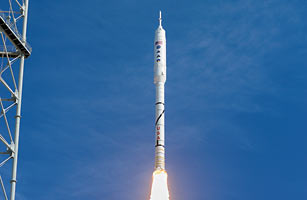
Metal has no DNA; machines have no genes. But that doesn't mean they don't have pedigrees — ancestral lines every bit as elaborate as our own. That's surely the case with the Ares 1 rocket. The best and smartest and coolest thing built in 2009 — a machine that can launch human beings to cosmic destinations we'd never considered before — is the fruit of a very old family tree, one with branches grand, historic and even wicked.
There are a lot of reasons astronauts haven't moved beyond the harbor lights of low-Earth orbit in nearly 40 years, but one of them is that we haven't had the machines to take us anywhere else. The space shuttle is a flying truck: fine for the lunch-bucket work of hauling cargo a couple of hundred miles into space, but nothing more. In 2004, however, the U.S. committed itself to sending astronauts back to the moon and later to Mars, and for that, you need something new and nifty for them to fly. The answer is the Ares 1, which had its first unmanned flight on Oct. 28 and dazzled even the skeptics.
From a distance, the rocket is unprepossessing — a slender white stalk that looks almost as if it would twang in the Florida wind. But up close, it's huge: about 327 ft. (100 m) tall, or the biggest thing the U.S. has launched since the 363-ft. (111 m) Saturn V moon rockets of the early 1970s. Its first stage is a souped-up version of one of the shuttle's solid-fuel rockets; its top stage is a similarly muscled-up model of the Saturn's massive J2 engines.
If that general body plan doesn't exactly break ground, that's the point. NASA tried breaking ground with the shuttles and in doing so broke all the rules. Shuttle astronauts sit alongside the fuel — next to the exploding motor that claimed Challenger, beneath the chunks of falling foam that killed Columbia. And when you fly a spacecraft repeatedly as opposed to chucking it after a single use, there's a lot of wear to repair.
When NASA engineers gathered to plan the next generation of America's rockets, they thus decided to go back to the future — way back. The Saturn V was the brainchild of Wernher von Braun, the German scientist whose bright genius gave the U.S. its finest line of rockets — and whose dark genius gave Hitler the V2 missile that rained terror on London. Von Braun had, in turn, drawn insights from American rocket pioneer Robert Goddard. Goddard built on the work of 17th century artillery innovator Kazimierz Siemienowicz, a Pole.
The Ares 1 is a worthy descendant of their rockets and others, with lightweight composites, better engines and exponentially improved computers giving it more reliability and power. The Ares 1 will launch an Apollo-like spacecraft with four crew members — perhaps by 2015. Alongside it, NASA is developing the Brobdingnagian Ares V, a 380-ft. (116 m) behemoth intended to put such heavy equipment as a lunar lander in Earth orbit, where astronauts can link up with it before blasting away to the moon. Somewhere between the two rockets is the so-called Ares Lite — a heavy-lift hybrid that could carry both humans and cargo and is intended to be a design that engineers can have in their back pockets if the two-booster plan proves unaffordable.
The new rockets could take astronauts to some thrilling places. The biggest costs — and risks — associated with visiting other celestial bodies are from landing and taking off again. But suppose you don't land? An independent commission appointed by the White House to make recommendations for NASA's future recently returned its 154-page report and made strong arguments for bypassing the familiar boots-in-the-soil scenario in favor of a flexible path of flybys and orbits.
Under the new thinking, astronauts could barnstorm or circle the moon, Mars and Mars' twin moons, deploying probes to do their rock-collecting and experiments for them. They could similarly sample near-Earth objects like asteroids. They could also travel to what is known as the Lagrange points — a scattering of spots between Earth and the moon and Earth and the sun where the gravitational forces on the bodies are precisely balanced and spacecraft simply ... hang where they are. These would serve as ideal spots for deploying probes and conducting cosmic observations.
Troublingly for Ares partisans, the same commission that called for such creative uses for the new rockets also called into question how affordable they are, arguing that it might be better simply to modify boosters now used to carry satellites and put a capsule on top. Maybe — but there's the question of safety too. NASA designers say the Ares line will be 10 times as safe as the shuttle and two to three times as safe as competing boosters.
There's no way of knowing if those projections are too rosy, but if history teaches us anything, it's that the space program's grimmest chapters — the launchpad fires and shuttle disasters — unfold when policy planners lean too hard on engineers. The finest moments occur when the bureaucrats give the designers a clean sheet of drafting paper and let them dream. There's genius in knowing how to create a truly big invention — and there's wisdom in knowing how to recognize it and use it.